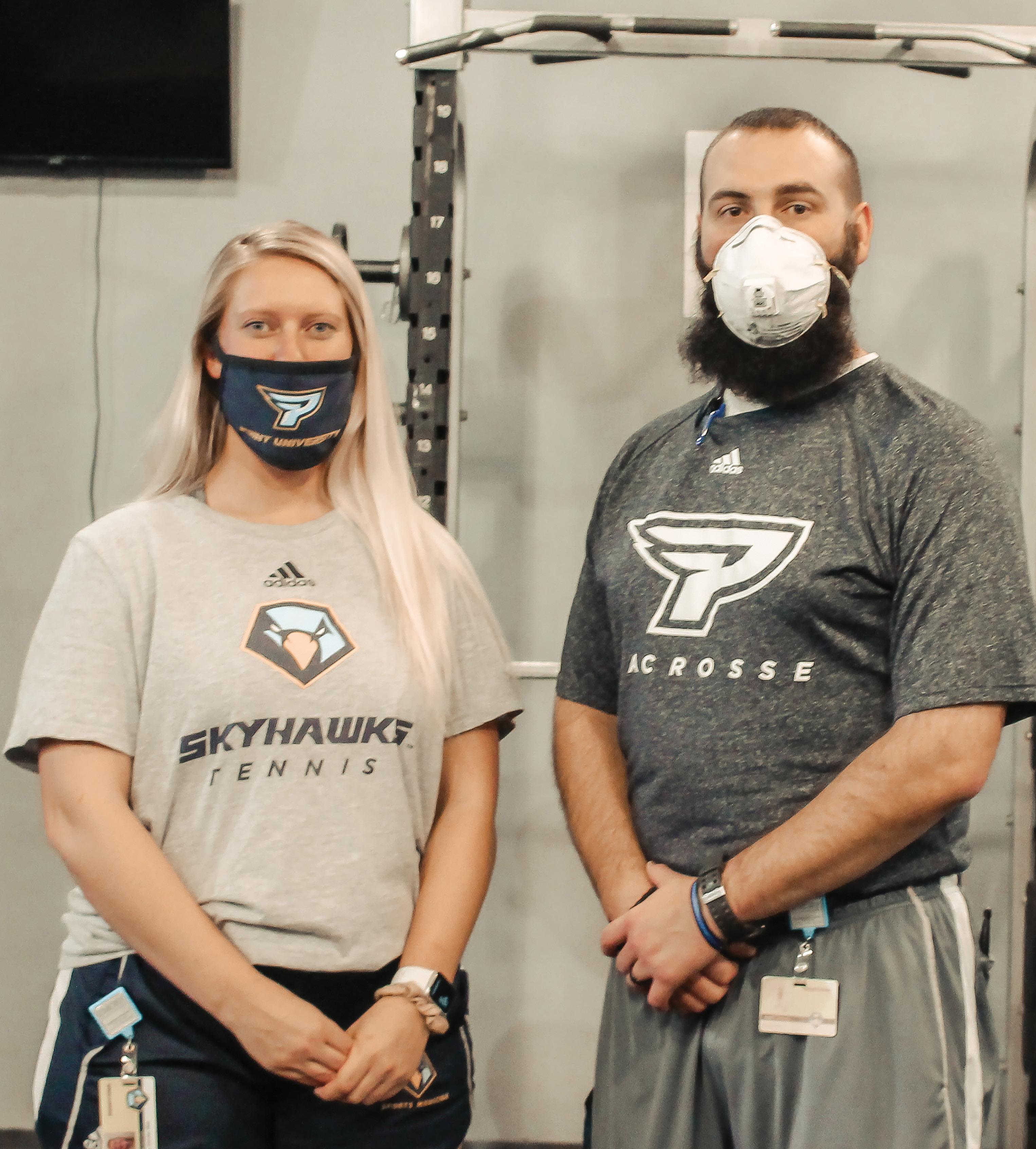
4 minute read
Bird's Eye View: Spring 2021
Adam Daum, head athletic trainer, and Dana Vander Wal, assistant athletic trainer
Point’s sports medicine team on the University’s COVID-19 response
BY KASSI BUTCHER
With the ongoing pandemic affecting how people live their daily lives, Point University’s administrators and staff made it their mission at the beginning of the school year to try to create a college experience for all Point students that would be as normal as possible, but also safe. Because so many of Point’s students are also athletes, it has fallen to the sports medicine team to work tirelessly to try to create a safe environment for Point’s 19 athletic teams, so that each could participate in a season resembling a typical one.
“The pandemic is certainly like nothing I have ever seen before,” says Head Athletic Trainer Adam Daum.
Daum spent a lot of his summer joining multiple weekly Zoom meetings with senior administrators and other individuals who acted as decision makers regarding COVID-19 at Point. Daum says that discussions frequently centered around how and what students returning to campus would look like for the fall semester after being sent home during the spring. “As the summer drew to a close and the semester came closer and closer, I realized the sports medicine department would be more instrumental in the process of returning people to campus than any of us had originally anticipated,” Daum says.
With the fall semester quickly approaching, the sports medicine team continued to keep the well-being of student-athletes as their top priority. This focus now included incorporating safety protocols to help prevent the spread of COVID-19.
“Our focus not only included the student-athletes, but now the entire Point community and how to keep everyone safe and healthy,” Daum says. “While the circumstances had changed and the logistical component transitioned into something larger, the end goal remained the same: health and wellness of the Point community.”
“I would say the first ‘step’ for us was creating policies and procedures which would be effective, but also practical,” he adds. “We knew they had to possess the ability to be implemented within the confines of the resources we had or could obtain.”
Assistant Athletic Trainer Andrew Welch says that putting in extra safety and health measures allowed the team to track symptoms and exposures to try to prevent COVID-19 from affecting any other students. “The earlier we could notice these potential cases, the more prepared the team and the athletic department could be for the next steps,” Welch says.
One of the main tools that helped the team monitor symptoms among the Point community was an app called TalonView. TalonView has provided students, faculty and staff an easy way to report any symptoms or exposures they might have had. All three groups are required to complete daily check-ins via the app prior to entering campus facilities.
As the pandemic has continued to progress into the spring semester yet again, Daum says the sports medicine team has continued to be proactive with implementing precautionary measures above the minimum standards set forth by both institutional and local governing authorities. These precautionary measures include enforcing facial covering while inside buildings, social distancing implementations, and sanitizing and disinfecting on a greater, detailed level with increased frequency and volume.
Monitoring the spread has been a top priority amongst the COVID-19 advisory team as the group has kept an eye on trends locally, regionally and nationally. The team has also monitored any changes and the latest recommendations from the Georgia Department of Public Health, the Centers for Disease Control and the World Health Organization. “The COVID advisory board’s decisions have been very influential in the minor adjustments our department has made,” Daum says.
The department has had to take on more responsibilities than they would during a regular year. Their roles now not only involve keeping student-athletes physically ready for competition, but also helping prevent them from contracting the coronavirus.
“I think the most challenging aspect for me has been the minute details,” Daum says. “The tediousness of it all and the sheer volume of necessary inter- and intra-departmental communication to help keep everyone on the same page. The most eye-opening for me would be how just a ‘few’ simple additional tasks and responsibilities can be so time- and resource-consuming.”
The team has not only had to keep their materials and training rooms sanitized and disinfected, but has been responsible for providing every athletic team with sanitation and disinfectant resources. They have also helped communicate to each team how to best conduct socially distanced practices, meetings and gatherings.
The sports medicine team’s goal is to be able to move forward to “normal” routines once again and not take anything for granted. “As athletic trainers, we get to experience so much,” says Welch. “Seeing the joy on athletes’ faces when we celebrate achievements tops anything. Whether it be a return from injury, or championship celebrations, we get to ride along side of them in the high times and low.”
“The hype of game day, the athletic training room conversations, and so much more; you don’t really understand the difference the small things make until they’re taken away,” he adds. “I pray that we take full advantage of our everyday joys as we try to get back to ‘normal’ routines and remember the lows that COVID-19 brought us as we work together for a healthy future.”

—ADAM DAUM, HEAD ATHLETIC TRAINER





